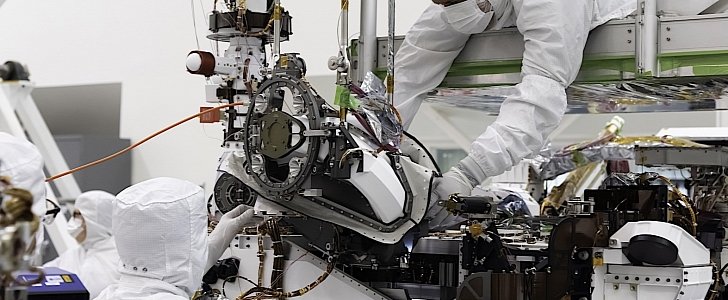One of the many missions the new Mars rover will be tasked with once it lands on Mars in 2021 is the collection of samples for shipment back to Earth. If this mission succeeds, it would be for the first time in history that humans have managed to mail themselves pieces of another planet.
To be up for the task, the rover needs special equipment, which it got last week in the NASA facilities where it is being assembled.
As per the space agency, the last pieces of the mechanisms that will be used for sample collection was fitted in the rover last week. Part of the Sample Caching System of the machine, the so-called bit carousel that got installed is essential for this mission.
The carousel comprises nine drill bits that will be used to dig holes into the Martian surface and collect samples. These drill bits are meant for different types of operations and soil: two for abrading, one for regolith, and six for coring.
Once drilled out and picked up, the samples are to be tucked away in tubes for storage. The theory is that at one point these tubes will be picked up by the Sample Return mission NASA is currently working on together with its European counterpart, ESA.
All samples will be loaded into a single large canister the size of a basketball that will be picked up from Mars by a departing spaceship and sent back to Earth. All this should happen, according to the NASA timetable, by the end of the next decade.
In simpler words, as Mars 2020 sample handling delivery manager Keith Rosette says, the carousel installed last week is at the heart of the mission at hand.
"It contains all of the tools the coring drill uses to sample the Martian surface and is the gateway for the samples to move into the rover for assessment and processing," he said.
The next Mars mission will leave Earth next year and has a landing date set for February 2021.
As per the space agency, the last pieces of the mechanisms that will be used for sample collection was fitted in the rover last week. Part of the Sample Caching System of the machine, the so-called bit carousel that got installed is essential for this mission.
The carousel comprises nine drill bits that will be used to dig holes into the Martian surface and collect samples. These drill bits are meant for different types of operations and soil: two for abrading, one for regolith, and six for coring.
Once drilled out and picked up, the samples are to be tucked away in tubes for storage. The theory is that at one point these tubes will be picked up by the Sample Return mission NASA is currently working on together with its European counterpart, ESA.
All samples will be loaded into a single large canister the size of a basketball that will be picked up from Mars by a departing spaceship and sent back to Earth. All this should happen, according to the NASA timetable, by the end of the next decade.
In simpler words, as Mars 2020 sample handling delivery manager Keith Rosette says, the carousel installed last week is at the heart of the mission at hand.
"It contains all of the tools the coring drill uses to sample the Martian surface and is the gateway for the samples to move into the rover for assessment and processing," he said.
The next Mars mission will leave Earth next year and has a landing date set for February 2021.







